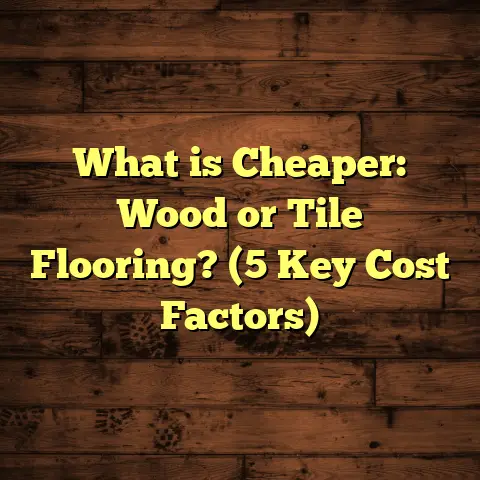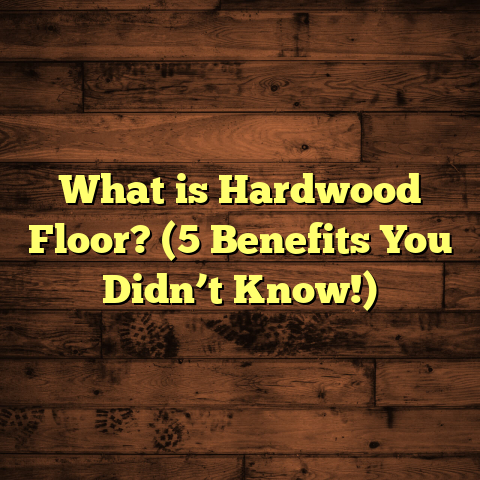What Is Brick Floor? (5 Key Benefits for Homeowners)
What Is Brick Floor?
Have you ever wondered if there’s a flooring option that can bring both timeless charm and rugged durability to your home? That’s where brick flooring makes its mark. If you’ve seen old farmhouses or historic buildings with those warm, reddish floors that seem like they’ve been around forever, you’re looking at brick floors.
Brick flooring is exactly what it sounds like: floors made from natural clay bricks. These bricks are kiln-fired at extremely high temperatures—around 2,000°F (1,093°C)—to become hard enough to handle years of wear and tear. Unlike the vertical brick walls you see everywhere, these bricks are laid flat on the floor, bonded together with mortar or specialized adhesives, to create a strong and often decorative surface.
The Basics of Brick Flooring
Most bricks used for flooring come in standard sizes, typically about 4 inches by 8 inches (10 cm x 20 cm), with a thickness of roughly 1 to 2 inches (2.5 cm to 5 cm). The thickness matters because it affects the height of your floor relative to other surfaces. For example, installing brick flooring might raise the floor level by an inch or two, which means you’ll have to adjust door heights or thresholds accordingly.
Installation times vary but generally expect about 3 to 5 days for an average-sized room of 200 square feet (about 18.5 square meters). This includes preparing the subfloor, laying bricks in the pattern chosen, grouting or mortaring, and allowing drying and sealing time.
Costs You Should Expect
Brick flooring costs are influenced by several factors: quality of the bricks, labor rates in your region, complexity of the pattern, and whether you choose reclaimed or new bricks. On average:
- Material costs range between $5 and $12 per square foot.
- Labor can add $8 to $18 per square foot.
- Sealing and finishing tack on another $1 to $3.
So, all in, most homeowners pay anywhere from $15 to $35 per square foot for brick floors. If you’re installing in a high-cost city like San Francisco or New York, expect prices near the upper end. In rural or less expensive areas, you might find deals closer to $15-$20 per square foot.
A Personal Story: The Charleston Restoration
I first got hooked on brick floors during a historic home project in Charleston, South Carolina. This particular home was built in the late 1800s and still had original brick floors in the kitchen and sunroom. They were worn but intact after more than 120 years! Restoring those bricks was a lesson in patience and respect for craftsmanship.
We carefully cleaned each brick by hand, replaced damaged ones with reclaimed bricks from nearby demolitions, and regrouted everything with a lime-based mortar that allowed the floor to breathe. When the project was done, the floors looked stunning but more importantly—they felt like they’d last another century.
5 Key Benefits of Brick Flooring for Homeowners
Choosing a floor isn’t just about looks; it’s about how well it fits your lifestyle. Here’s what brick floors offer that I think make them a must-have for many homeowners.
1. Durability That Lasts Generations
Durability is what sets brick floors apart from many other options. Clay bricks fired at high temperatures become extremely hard—rated around 6 to 7 on the Mohs hardness scale—meaning they resist scratches and impacts better than typical hardwoods or laminates.
Think about your busiest rooms—kitchens, entryways, mudrooms—where foot traffic is highest. Brick can handle it without showing wear easily. I’ve installed brick floors in several family homes where kids run around all day, pets roam freely, and yet there’s little sign of damage even after a decade.
Real Data on Durability
A study from the National Institute of Building Sciences showed that brick paving can last over 50 years with minimal maintenance when installed correctly. Compare that to carpet which might need replacement every 7-10 years or hardwood floors needing refinishing every 5-10 years.
One homeowner in Dallas who installed brick floors in their garage and outdoor patio told me they’re still flawless after eight years—even under intense sun and heavy use.
2. Natural Heat Regulation: Warm in Winter, Cool in Summer
Thermal mass is a property many homeowners overlook but it can save money on heating and cooling bills. Bricks absorb heat during warm parts of the day and slowly release it at night. This helps keep indoor temperatures stable without cranking up your HVAC system.
When I installed brick flooring in a sunroom in Phoenix, Arizona, the client noticed that on hot days the floor remained cool underfoot. Conversely, during winter nights, after heating the room all day, the bricks continued radiating warmth for hours.
Energy Savings Backed by Research
According to data from the U.S. Department of Energy, incorporating materials with high thermal mass like brick or concrete can reduce heating and cooling energy use by up to 10-15%. For an average household spending $2,000 annually on energy bills, that’s up to $300 saved per year.
3. Low Maintenance That Saves You Money Over Time
I always tell my clients that one of brick flooring’s best perks is how easy it is to maintain compared to alternatives like hardwood or carpet.
Routine care involves simple sweeping to remove dirt and dust. Occasional mopping with mild soap keeps the surface fresh. The crucial step is sealing the bricks after installation—and reapplying sealant every few years—to protect against stains and moisture.
In practical terms, homeowners spend less than $100 per year on upkeep for brick floors. Contrast this with hardwood floors which might need sanding and refinishing every few years costing thousands over time.
Saving Case Study: Oregon Family
A family I consulted with in Oregon switched their living room floor from engineered hardwood to brick a few years ago. Over five years, they saved over $2,000 on maintenance alone since they didn’t have to refinish or replace damaged planks.
4. Unique Style With Endless Design Options
If you want floors that actually draw compliments from guests, brick makes a statement. Each brick has unique color variations—reds, browns, tans—that give a natural warmth impossible to replicate with vinyl or laminate.
Plus, there’s lots of flexibility with patterns:
- Running bond: Simple staggered rows.
- Herringbone: Zig-zag pattern for a classic look.
- Basketweave: Blocks arranged in squares.
- Stack bond: Bricks aligned straight in rows for modern minimalism.
I once mixed reclaimed vintage bricks with new ones for a farmhouse kitchen remodel. The mismatched colors created a beautiful patchwork effect that guests loved.
5. Eco-Friendly Flooring Option
Sustainability is gaining ground as a priority for homeowners today. Brick flooring fits well here since bricks are made from natural clay and shale with minimal processing and no harmful chemicals.
Even better—reclaimed bricks from old buildings can be reused in new floors! This reduces waste going to landfills and preserves historic character.
I’ve worked on several projects where clients sourced reclaimed bricks from barns or factories nearby. Not only did this save money but also gave their homes stories embedded right into the floor.
Installation Insights: What You Need to Know
Installing brick floors isn’t as simple as laying carpet or snapping laminate panels together. It requires proper preparation and technique for longevity.
Subfloor Preparation
The best base is a solid concrete slab. If your home has wooden subfloors (common in older houses), you’ll need cement backer boards or additional reinforcement since bricks are heavy.
During one project in Boston on an old Victorian home with timber floors below, we had to reinforce joists before installation—a process that added two extra days but guaranteed no cracking later.
Laying Patterns & Mortar Choices
The pattern you select affects both aesthetics and installation time. Complex layouts like herringbone require careful measurement and cutting of bricks; simple running bond is quicker.
Mortar acts as glue between bricks but must be chosen carefully. For interior floors subject to moisture (like kitchens), polymer-modified mortar ensures better bonding and flexibility.
Sealing & Finishing
Sealing seals pores in bricks preventing water damage and stains from spills like wine or oil. I recommend using penetrating sealers that don’t change the natural look but protect underfoot.
Reapplication every 3-5 years keeps the floor looking fresh.
Costs Breakdown With Examples
Here’s a detailed cost breakdown from recent projects I’ve done across different regions:
| Location | Size (sq ft) | Material Cost | Labor Cost | Total Cost (per sq ft) |
|---|---|---|---|---|
| Charleston, SC | 250 | $7 | $10 | $17 |
| Phoenix, AZ | 400 | $9 | $14 | $23 |
| Portland, OR | 350 | $6 | $11 | $17 |
| Dallas, TX | 300 | $5 | $8 | $13 |
Materials ranged from new clay bricks to reclaimed options depending on client preference. Labor includes subfloor prep, laying bricks, grouting, and sealing.
Common Questions I Hear About Brick Floors
Q: Are brick floors cold and hard?
Brick is naturally hard, but adding area rugs or radiant heating underneath solves coldness issues nicely. It’s actually warmer than tile due to its thermal mass.
Q: Can bricks crack?
If installed properly on a stable subfloor with good mortar joints, cracks are rare. Heavy impacts can cause damage anywhere though.
Q: How do brick floors compare with tile?
Bricks tend to be thicker (1-2 inches vs tile’s ~0.5 inch), giving more thermal mass but also more weight. Tiles offer more uniformity; bricks have rustic charm.
Q: How long does installation take?
For an average room (200 sq ft), expect about 3-5 days including prep and curing times.
My Favorite Brick Floor Projects
Historic Renovation in Charleston
This project taught me the value of patience restoring century-old bricks using traditional materials like lime mortar instead of modern cement-based mixes. The result was authentic character preserved while making floors safe for daily use.
Modern Farmhouse Kitchen
Here I combined new matte-finish red bricks laid in basketweave pattern with reclaimed accent bricks around edges for contrast. The homeowners loved how warm yet practical it felt with their kids playing on it daily.
Sunroom Heating Solution in Phoenix
Installing radiant heat beneath brick floors gave the space year-round comfort without sacrificing style or energy efficiency—clients appreciated both aesthetics and function here.
Final Thoughts
Brick flooring might not be the first thing you think of when remodeling your home—but maybe it should be! With durability that lasts decades if not centuries; natural temperature regulation; low ongoing maintenance; unique style options; plus eco-friendly credentials—it ticks many boxes for homeowners wanting lasting value.
If you want a floor that tells a story while standing up to everyday life—and maybe saves some energy costs too—brick flooring deserves serious thought.
Got questions about specific designs or need help finding suppliers near you? Just ask—I’m here to help you get it right!





